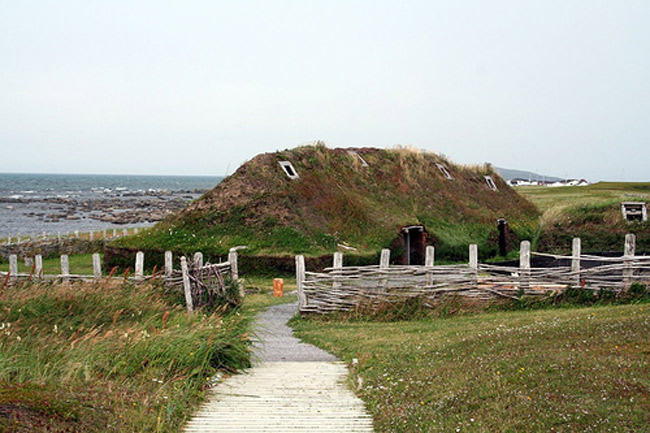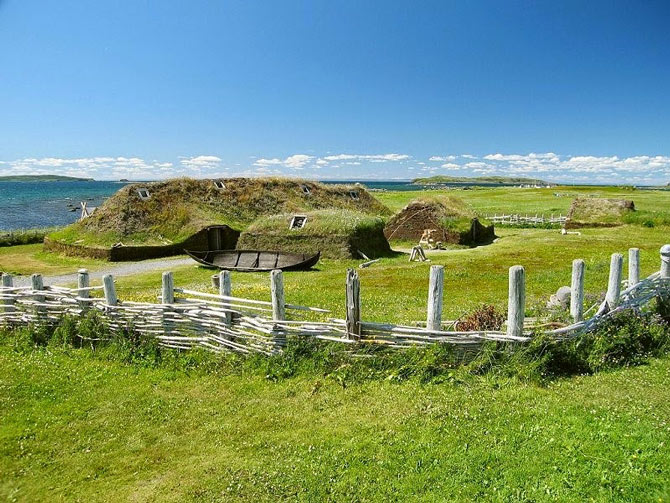Archaeological site L 'Anse aux Meadows - Canada
Unesco's Science, Education and Culture Organization recognized the archaeological site of L'Anse aux Meadows of Canada as a World Cultural Heritage in 1978.
L'Anse aux Meadows - A world cultural heritage in Canada
L'Anse aux Meadows archaeological site is an archaeological site located in northern Newfoundland Island in Canada. The area was discovered in 1960, formerly a settlement of Norse and Vikings - famous in human history.

This site was first named Anse à la Médeé , which was obtained through a French chart made in 1862. It was later renamed L'Anse aux Meadows, the reason why the name changed. it is still unknown.
L'Anse aux Meadows is recognized as the site of the largest Nordic people in North America. After studying, studying at this site, many theories suggest that the Vikings found America, not Christopher Columbus.



Some remaining ancient works are still maintained and protected at the heritage site
L'Anse aux Meadows consists of 3 areas, with traces of 8 buildings. By studying the remaining artifacts, archaeologists said they were built around the 11th century.
Especially in this area, there is evidence that once existed an iron forge here. Scientists believe that this is where the Vikings used to forge their boats.
As brave warriors and good farmers, raising livestock and poultry is considered to decide the survival of the Vikings. However, in L'Anse aux Meadows, no houses or tents for animals were ever found . From these evidence, archaeologists, historians and scientists have arisen. The theory was that the area was only a temporary settlement, a stepping stone for Vikings to travel and explore further.

However, previous archaeological documents have not revealed much about the Viking relationship with native Americans. This raised suspicions about the Vikings' arrival in the Americas. There are many conflicting ideas that still protect the point of view, Colombus is the one who discovered the "new world". The argument between the two factions, one side said that the Vikings had found America , and the opposition definitively supported the argument that Colombus had found America to have been going on for a very long time. Recently, Sutherland archaeologist published his studies and demonstrated Viking's interaction with Native Americans. Specifically, Sutherland and his team not only searched for evidence at L'Anse aux Meadows, but this famous archaeologist also excavated in many other areas such as Baffin Island, Tanfield Valley . Amazing In fact, her studies were derived from a more than 700-year-old soft cord on Baffin Island. The yarns are woven from short fur fibers, while the Baffin natives sew only fur coats and do not know how to weave fabrics.


There are many theories and arguments about the Vikings finding America and not Columbus.
This paradox was decoded in 1999 when Sutherland discovered that the same thread resembled a similar thing in Greenland - the remains of the Vikings. This urged Sutherland to find a truly forgotten relationship in history.
After years of searching, in the archaeological areas of North America, Sutherland's team has found a lot of similar pieces of cloth and ropes. They also discovered 30 traditional Scandinavian stone artifacts that only Vikings used. Another compelling evidence is the small wooden sticks - an indispensable item in the Viking trade. In the past, the Vikings must have set foot in this place, using familiar wooden sticks to record trade with indigenous people. After years of research, searching, decoding, Sutherland archaeologist and her team came up with the shocking hypothesis: the Vikings first arrived in North America. They came here to explore, search for fur, walrus, as well as precious products from the North Pole to trade in Europe. Here, they met the first Aboriginal people of the Americas. There was not so much conflict between them, but they lived for a while, before the Vikings sailed into the sea and returned to Europe. However, this research is not enough to confirm the world so it is still necessary for anyone to make a heart to America .

Northern Europeans settled in L'Anse aux Meadows from about 1,000 years ago. This area is now a vast grassland area. Archaeological site L'Anse aux Meadows was recognized by Unesco as a World Heritage by criteria (vi): L'Anse aux Meadows archaeological site is the place where Vikings once lived, this is the earliest evidence about Europeans in the new world. In addition, this heritage is particularly valuable because it is evidence of human migration in the history of development.



- Archaeological findings 'cannot explain'
- The Vikings found America before Columbus?
- The archaeological site is known as the
- The site of the archaeological site of Hoang Thanh
- Kernavé archaeological site - World cultural heritage in Lithuania
- Archaeological site of Lenggong valley
- Discover the oldest traces of modern Europeans
- Many discoveries at the archaeological site of Con Moong cave
- Archaeological site Epidaurus
- Archaeological site Fuerte de Samaipata
- Complete excavation of archaeological site in Kon Tum
- Discovered a thousand year old gold grave in Panama
 Suzhou classic bonsai garden - China
Suzhou classic bonsai garden - China Chau Nguyen Dynasty
Chau Nguyen Dynasty Thai Son Mountain - World Wonder
Thai Son Mountain - World Wonder Ancient villages of Shirakawa-go and Gokayama
Ancient villages of Shirakawa-go and Gokayama